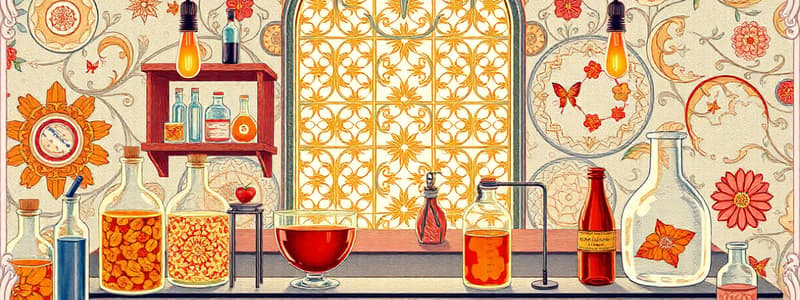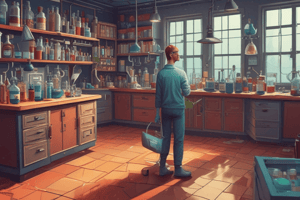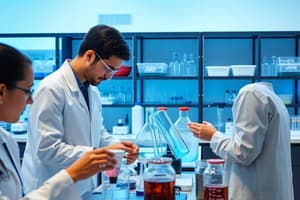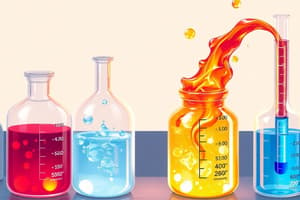Podcast
Questions and Answers
Which of the following is NOT a special precaution for working with heat or fire?
Which of the following is NOT a special precaution for working with heat or fire?
- Inflammable liquid bottles should not be dispensed near a naked flame.
- Never handle hot materials without wearing gloves. (correct)
- Never leave a lighted Bunsen burner unattended.
- Use test tube holders to handle hot laboratory equipment.
- Use only Pyrex glassware's for heating.
What are the main types of hazards that laboratory safety symbols are designed to warn people of?
What are the main types of hazards that laboratory safety symbols are designed to warn people of?
- Physical and chemical hazards
- Biological and chemical hazards
- All potential hazards (correct)
- Electrical hazards only
- Chemical hazards only
It is acceptable to leave a hot object unattended after removing it from a heat source.
It is acceptable to leave a hot object unattended after removing it from a heat source.
False (B)
When diluting acid, what is the correct procedure?
When diluting acid, what is the correct procedure?
Always smell substances in the laboratory without specific instructions.
Always smell substances in the laboratory without specific instructions.
A good way to prevent accidents is to wear open shoes, such as sandals, when working in a laboratory.
A good way to prevent accidents is to wear open shoes, such as sandals, when working in a laboratory.
When working with chemicals, it is crucial to ensure all containers are ______.
When working with chemicals, it is crucial to ensure all containers are ______.
What is the primary purpose of a lab coat?
What is the primary purpose of a lab coat?
It is acceptable to leave unused materials on the laboratory floor.
It is acceptable to leave unused materials on the laboratory floor.
When working in a laboratory, it is okay to run in case of an emergency if you need to reach a specific location quickly.
When working in a laboratory, it is okay to run in case of an emergency if you need to reach a specific location quickly.
What should be done if you find damaged laboratory apparatus?
What should be done if you find damaged laboratory apparatus?
Why is it important to wash your hands after working with chemicals?
Why is it important to wash your hands after working with chemicals?
What steps should be taken if a chemical is accidentally swallowed?
What steps should be taken if a chemical is accidentally swallowed?
Which of the following symbols represents a corrosive substance?
Which of the following symbols represents a corrosive substance?
What are two reasons why it's important to keep exits and passageways clear in the laboratory?
What are two reasons why it's important to keep exits and passageways clear in the laboratory?
It is acceptable to use broken or chipped glassware in the laboratory.
It is acceptable to use broken or chipped glassware in the laboratory.
What should be done to clean broken glass safely in the laboratory?
What should be done to clean broken glass safely in the laboratory?
What is the purpose of laboratory safety symbols?
What is the purpose of laboratory safety symbols?
Chemicals labeled as toxic can cause death if they penetrate the skin, are inhaled, or are swallowed.
Chemicals labeled as toxic can cause death if they penetrate the skin, are inhaled, or are swallowed.
Flammable substances are not hazardous if they are kept away from open flames and electricity.
Flammable substances are not hazardous if they are kept away from open flames and electricity.
Where should a hot object be placed after it has been removed from a heat source?
Where should a hot object be placed after it has been removed from a heat source?
It is safe to leave flammable liquid bottles open in a laboratory even if they are not near heat.
It is safe to leave flammable liquid bottles open in a laboratory even if they are not near heat.
Describe the appropriate procedure for cleaning up a chemical spill on the floor.
Describe the appropriate procedure for cleaning up a chemical spill on the floor.
Why is it important to use only Pyrex glassware for heating?
Why is it important to use only Pyrex glassware for heating?
It is acceptable to work with live animals in a laboratory without any specific instructions.
It is acceptable to work with live animals in a laboratory without any specific instructions.
Laboratory safety symbols are designed to warn people only about the potential dangers of chemical substances.
Laboratory safety symbols are designed to warn people only about the potential dangers of chemical substances.
The symbols used to communicate laboratory safety are considered universal and are understood by people from different cultures.
The symbols used to communicate laboratory safety are considered universal and are understood by people from different cultures.
It is acceptable to unplug an appliance without turning off the power switch.
It is acceptable to unplug an appliance without turning off the power switch.
What are some examples of common laboratory equipment that might be dangerous to handle if it is hot?
What are some examples of common laboratory equipment that might be dangerous to handle if it is hot?
It is better to wear gloves than to wash your hands when working with chemicals.
It is better to wear gloves than to wash your hands when working with chemicals.
It is okay to work in a laboratory with wet hands.
It is okay to work in a laboratory with wet hands.
What are the risks of working with live cultures in a laboratory?
What are the risks of working with live cultures in a laboratory?
What is the purpose of detergents in a laboratory?
What is the purpose of detergents in a laboratory?
Wearing a lab coat in the laboratory is only necessary when working with chemicals.
Wearing a lab coat in the laboratory is only necessary when working with chemicals.
Flashcards
Laboratory Safety
Laboratory Safety
Practices to prevent accidents and injuries in labs.
Hazardous Materials
Hazardous Materials
Materials that can cause health issues or damage.
Lab Coat Requirements
Lab Coat Requirements
Wear a closed, clean lab coat knee-length at all times.
No Eating or Drinking
No Eating or Drinking
Signup and view all the flashcards
Handling Chemicals
Handling Chemicals
Signup and view all the flashcards
Heat Precautions
Heat Precautions
Signup and view all the flashcards
Glassware Safety
Glassware Safety
Signup and view all the flashcards
Electrical Safety
Electrical Safety
Signup and view all the flashcards
Emergency First Aid
Emergency First Aid
Signup and view all the flashcards
Chemical Handling Tips
Chemical Handling Tips
Signup and view all the flashcards
Personal Hygiene in Lab
Personal Hygiene in Lab
Signup and view all the flashcards
Petri Dish Safety
Petri Dish Safety
Signup and view all the flashcards
Toxic Chemicals
Toxic Chemicals
Signup and view all the flashcards
Flammable Materials
Flammable Materials
Signup and view all the flashcards
Corrosive Chemicals
Corrosive Chemicals
Signup and view all the flashcards
Specimen Care
Specimen Care
Signup and view all the flashcards
Bunsen Burner Safety
Bunsen Burner Safety
Signup and view all the flashcards
Lab Equipment Familiarity
Lab Equipment Familiarity
Signup and view all the flashcards
Chemical Disposal
Chemical Disposal
Signup and view all the flashcards
Using Test Tube Holders
Using Test Tube Holders
Signup and view all the flashcards
Cleaning Glassware
Cleaning Glassware
Signup and view all the flashcards
Use of Detergents
Use of Detergents
Signup and view all the flashcards
Hoses and Equipment Checks
Hoses and Equipment Checks
Signup and view all the flashcards
Proper Use of Electrical Devices
Proper Use of Electrical Devices
Signup and view all the flashcards
Safety in Lab
Safety in Lab
Signup and view all the flashcards
Hazard Awareness
Hazard Awareness
Signup and view all the flashcards
Lab Equipment Handling
Lab Equipment Handling
Signup and view all the flashcards
Children in Labs
Children in Labs
Signup and view all the flashcards
Restricted Actions
Restricted Actions
Signup and view all the flashcards
Lab Coat Policy
Lab Coat Policy
Signup and view all the flashcards
Footwear Guidelines
Footwear Guidelines
Signup and view all the flashcards
Movement in Lab
Movement in Lab
Signup and view all the flashcards
Clear Exits
Clear Exits
Signup and view all the flashcards
Material Use Policy
Material Use Policy
Signup and view all the flashcards
Discarding Damaged Equipment
Discarding Damaged Equipment
Signup and view all the flashcards
Reagent Storage
Reagent Storage
Signup and view all the flashcards
Apparatus Cleanup
Apparatus Cleanup
Signup and view all the flashcards
Hand Hygiene
Hand Hygiene
Signup and view all the flashcards
Hazardous Material Definition
Hazardous Material Definition
Signup and view all the flashcards
Toxic Chemical Symbol
Toxic Chemical Symbol
Signup and view all the flashcards
Usage of Inflammable Materials
Usage of Inflammable Materials
Signup and view all the flashcards
Using Test Tube Holders Correctly
Using Test Tube Holders Correctly
Signup and view all the flashcards
Pyrex Glassware
Pyrex Glassware
Signup and view all the flashcards
Dilution of Acid
Dilution of Acid
Signup and view all the flashcards
Electrical Safety Checks
Electrical Safety Checks
Signup and view all the flashcards
Cleanliness with Glassware
Cleanliness with Glassware
Signup and view all the flashcards
Handling Live Specimens
Handling Live Specimens
Signup and view all the flashcards
Dissection Practices
Dissection Practices
Signup and view all the flashcards
Detergents for Sterilization
Detergents for Sterilization
Signup and view all the flashcards
Avoiding Broken Glass
Avoiding Broken Glass
Signup and view all the flashcards
Chemical Warning Symbols
Chemical Warning Symbols
Signup and view all the flashcards
First Aid for Burns
First Aid for Burns
Signup and view all the flashcards
Responding to Poisoning
Responding to Poisoning
Signup and view all the flashcards
General Lab Safety Knowledge
General Lab Safety Knowledge
Signup and view all the flashcards
Biohazard Awareness
Biohazard Awareness
Signup and view all the flashcards
Cold and Warming Equipment Safety
Cold and Warming Equipment Safety
Signup and view all the flashcards
Study Notes
UMST Preparatory College Biochemistry Practical NO (1): Lab Safety
- This practical focuses on lab safety procedures
- Students must adhere to safety guidelines before, during, and after lab work.
Preparing for Laboratory Work
- Before working in the lab, familiarize yourself with:
- Hazards of lab materials
- Material labels
- Proper handling procedures
Throughout Laboratory Work
- Obey these guidelines:
- Children are not allowed in the lab
- Avoid eating, drinking, smoking, using cosmetics, or handling contact lenses.
- Wear a closed, clean lab coat (knee-length) at all times.
- Do not wear open-toed shoes like sandals.
- Walk, do not run, in the lab.
- Keep exits and hallways clear.
- Only work with materials you've been instructed to use.
- Remove damaged equipment immediately.
- Do not leave reagent bottles (full or empty) on the floor.
- Return unused materials to their original location.
- Wash the equipment you used.
- Wash your hands thoroughly.
Hazardous Materials
- Hazardous materials can cause health issues, injuries, or property damage if not handled correctly.
- This includes solids, liquids, and gases that can harm people, organisms, property, or the environment.
Special Precautions for Working with Heat or Fire
- Never leave a lit Bunsen burner or hot object unattended.
- When an object is removed from the heat, place it where it's shielded from contact to cool down.
- Inflammable liquids should never be left open, near a naked flame, hot electric element, or electric motor.
- Use test tube holders to handle hot lab equipment.
- Always point the open end of a heated container away from yourself and others.
- Only use Pyrex glassware for heating.
- Allow hot materials to cool before moving them.
- Ensure Bunsen burner hoses are tightly connected.
Special Precautions for Working with Chemicals
- Never taste or touch substances without specific instructions.
- Never smell substances without specific instructions.
- Use chemicals only from properly labeled containers.
- Wash hands after working with chemicals.
- Do not add water to acid; always add acid to water to dilute it.
- Mix heat-generating chemicals slowly.
Special Precautions for Working with Electrical Equipment
- Ensure the area surrounding electrical equipment is dry to avoid accidents.
- Avoid touching electrical equipment with wet hands.
- Keep the area around electrical equipment free from flammable materials.
- Turn off power switches before plugging and unplugging appliances.
Special Precautions for Working with Glassware
- Familiarize yourself with glassware and equipment in the lab.
- Do not use broken or chipped glassware.
- Make sure glassware is clean before use.
- Do not pick up broken glass with your bare hands; use a pan and a brush.
Special Precautions for Working with Live or Preserved Specimens
- Treat live specimens gently and follow instructions for proper care.
- Wash hands after handling live or preserved specimens.
- Properly mount and support specimens for dissection.
- Do not cut specimens while holding them in the air.
- Do not open Petri dishes containing live cultures unless instructed.
- Use detergents (e.g., 5-10% detol) to sterilize and clean benches, glassware, and equipment.
- Wear lab coats
Hazard Warning Symbols
- A system of pictures warns of potential dangers in the lab; these are known as safety symbols.
Toxic
- Toxic chemicals can cause death if they penetrate the skin, are smelled, or swallowed.
Flammable
- Flammable substances ignite easily with heat or electricity.
Corrosive
- Corrosives destroy tissues, especially soft tissues.
Explosives
- Explosives are extremely dangerous, and need special handling according to lab procedures.
First Aid
- Immediately follow appropriate first-aid procedures if any injuries occur, for instance:
- Bleeding control: bandages and cleansing with iodine alcohol mixture
- Acid or fire burns: wash with water immediately
- Poisoning: identify the substance and seek appropriate treatment
- Skin contamination: wash with water to remove contaminants, and potentially soap if insoluble
Studying That Suits You
Use AI to generate personalized quizzes and flashcards to suit your learning preferences.




